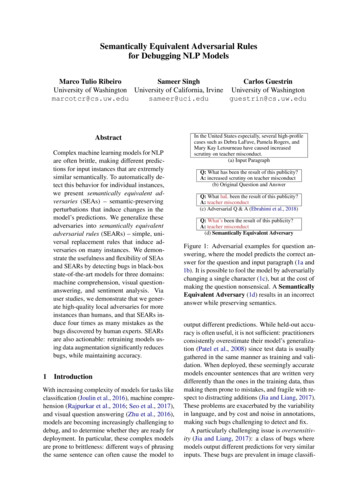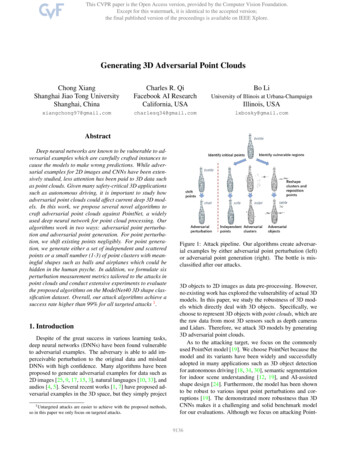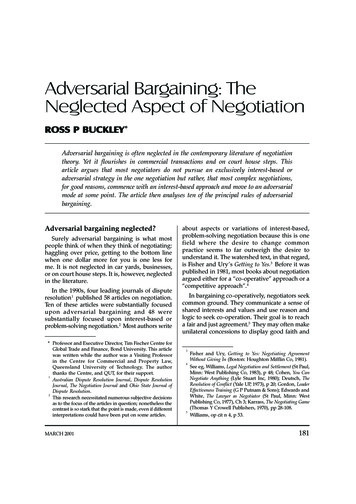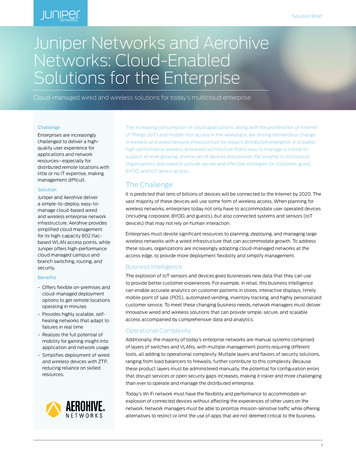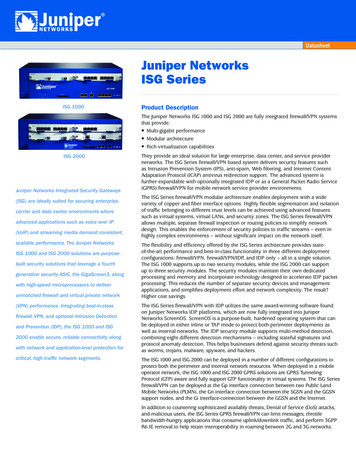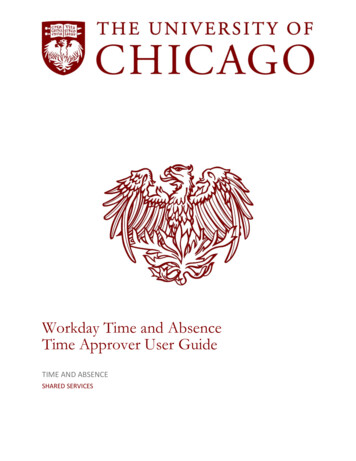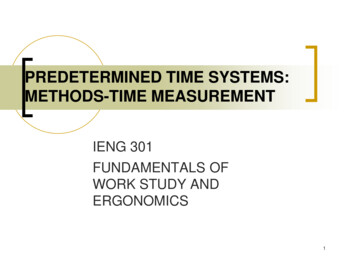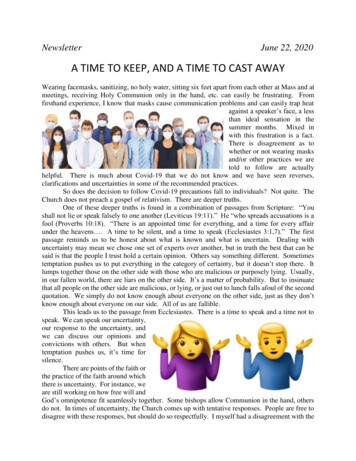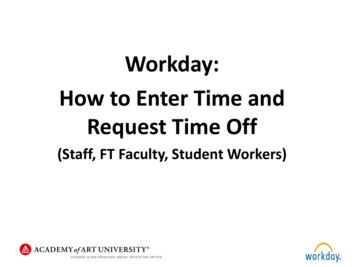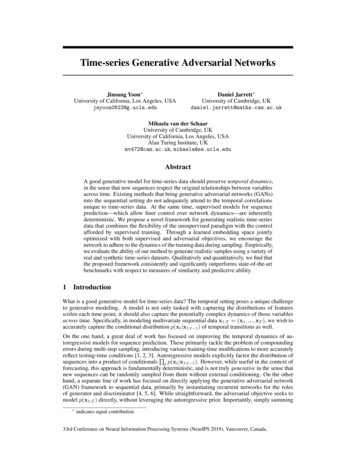
Transcription
Time-series Generative Adversarial NetworksJinsung Yoon University of California, Los Angeles, USAjsyoon0823@g.ucla.eduDaniel Jarrett University of Cambridge, UKdaniel.jarrett@maths.cam.ac.ukMihaela van der SchaarUniversity of Cambridge, UKUniversity of California, Los Angeles, USAAlan Turing Institute, UKmv472@cam.ac.uk, mihaela@ee.ucla.eduAbstractA good generative model for time-series data should preserve temporal dynamics,in the sense that new sequences respect the original relationships between variablesacross time. Existing methods that bring generative adversarial networks (GANs)into the sequential setting do not adequately attend to the temporal correlationsunique to time-series data. At the same time, supervised models for sequenceprediction—which allow finer control over network dynamics—are inherentlydeterministic. We propose a novel framework for generating realistic time-seriesdata that combines the flexibility of the unsupervised paradigm with the controlafforded by supervised training. Through a learned embedding space jointlyoptimized with both supervised and adversarial objectives, we encourage thenetwork to adhere to the dynamics of the training data during sampling. Empirically,we evaluate the ability of our method to generate realistic samples using a variety ofreal and synthetic time-series datasets. Qualitatively and quantitatively, we find thatthe proposed framework consistently and significantly outperforms state-of-the-artbenchmarks with respect to measures of similarity and predictive ability.1IntroductionWhat is a good generative model for time-series data? The temporal setting poses a unique challengeto generative modeling. A model is not only tasked with capturing the distributions of featureswithin each time point, it should also capture the potentially complex dynamics of those variablesacross time. Specifically, in modeling multivariate sequential data x1:T (x1 , ., xT ), we wish toaccurately capture the conditional distribution p(xt x1:t 1 ) of temporal transitions as well.On the one hand, a great deal of work has focused on improving the temporal dynamics of autoregressive models for sequence prediction. These primarily tackle the problem of compoundingerrors during multi-step sampling, introducing various training-time modifications to more accuratelyreflect testing-time conditions [1, 2, 3]. Autoregressivemodels explicitly factor the distribution ofQsequences into a product of conditionals t p(xt x1:t 1 ). However, while useful in the context offorecasting, this approach is fundamentally deterministic, and is not truly generative in the sense thatnew sequences can be randomly sampled from them without external conditioning. On the otherhand, a separate line of work has focused on directly applying the generative adversarial network(GAN) framework to sequential data, primarily by instantiating recurrent networks for the rolesof generator and discriminator [4, 5, 6]. While straightforward, the adversarial objective seeks tomodel p(x1:T ) directly, without leveraging the autoregressive prior. Importantly, simply summing indicates equal contribution33rd Conference on Neural Information Processing Systems (NeurIPS 2019), Vancouver, Canada.
the standard GAN loss over sequences of vectors may not be sufficient to ensure that the dynamics ofthe network efficiently captures stepwise dependencies present in the training data.In this paper, we propose a novel mechanism to tie together both threads of research, giving rise to agenerative model explicitly trained to preserve temporal dynamics. We present Time-series GenerativeAdversarial Networks (TimeGAN), a natural framework for generating realistic time-series data invarious domains. First, in addition to the unsupervised adversarial loss on both real and syntheticsequences, we introduce a stepwise supervised loss using the original data as supervision, therebyexplicitly encouraging the model to capture the stepwise conditional distributions in the data. Thistakes advantage of the fact that there is more information in the training data than simply whether eachdatum is real or synthetic; we can expressly learn from the transition dynamics from real sequences.Second, we introduce an embedding network to provide a reversible mapping between features andlatent representations, thereby reducing the high-dimensionality of the adversarial learning space.This capitalizes on the fact the temporal dynamics of even complex systems are often driven by fewerand lower-dimensional factors of variation. Importantly, the supervised loss is minimized by jointlytraining both the embedding and generator networks, such that the latent space not only serves topromote parameter efficiency—it is specifically conditioned to facilitate the generator in learningtemporal relationships. Finally, we generalize our framework to handle the mixed-data setting, whereboth static and time-series data can be generated at the same time.Our approach is the first to combine the flexibility of the unsupervised GAN framework with thecontrol afforded by supervised training in autoregressive models. We demonstrate the advantagesin a series of experiments on multiple real-world and synthetic datasets. Qualitatively, we conductt-SNE [7] and PCA [8] analyses to visualize how well the generated distributions resemble theoriginal distributions. Quantitatively, we examine how well a post-hoc classifier can distinguishbetween real and generated sequences. Furthermore, by applying the "train on synthetic, test on real(TSTR)" framework [5, 9] to the sequence prediction task, we evaluate how well the generated datapreserves the predictive characteristics of the original. We find that TimeGAN achieves consistentand significant improvements over state-of-the-art benchmarks in generating realistic time-series.2Related WorkTimeGAN is a generative time-series model, trained adversarially and jointly via a learned embeddingspace with both supervised and unsupervised losses. As such, our approach straddles the intersectionof multiple strands of research, combining themes from autoregressive models for sequence prediction,GAN-based methods for sequence generation, and time-series representation learning.Autoregressive recurrent networks trained via the maximum likelihood principle [10] are prone topotentially large prediction errors when performing multi-step sampling, due to the discrepancybetween closed-loop training (i.e. conditioned on ground truths) and open-loop inference (i.e.conditioned on previous guesses). Based on curriculum learning [11], Scheduled Sampling wasfirst proposed as a remedy, whereby models are trained to generate output conditioned on a mix ofboth previous guesses and ground-truth data [1]. Inspired by adversarial domain adaptation [12],Professor Forcing involved training an auxiliary discriminator to distinguish between free-runningand teacher-forced hidden states, thus encouraging the network’s training and sampling dynamics toconverge [2]. Actor-critic methods [13] have also been proposed, introducing a critic conditionedon target outputs, trained to estimate next-token value functions that guide the actor’s free-runningpredictions [3]. However, while the motivation for these methods is similar to ours in accounting forstepwise transition dynamics, they are inherently deterministic, and do not accommodate explicitlysampling from a learned distribution—central to our goal of synthetic data generation.On the other hand, multiple studies have straightforwardly inherited the GAN framework within thetemporal setting. The first (C-RNN-GAN) [4] directly applied the GAN architecture to sequentialdata, using LSTM networks for generator and discriminator. Data is generated recurrently, taking asinputs a noise vector and the data generated from the previous time step. Recurrent Conditional GAN(RCGAN) [5] took a similar approach, introducing minor architectural differences such as droppingthe dependence on the previous output while conditioning on additional input [14]. A multitude ofapplied studies have since utilized these frameworks to generate synthetic sequences in such diversedomains as text [15], finance [16], biosignals [17], sensor [18] and smart grid data [19], as well asrenewable scenarios [20]. Recent work [6] has proposed conditioning on time stamp information to2
handle irregularly sampling. However, unlike our proposed technique, these approaches rely onlyon the binary adversarial feedback for learning, which by itself may not be sufficient to guaranteespecifically that the network efficiently captures the temporal dynamics in the training data.Finally, representation learning in the time-series setting primarily deals with the benefits of learningcompact encodings for the benefit of downstream tasks such as prediction [21], forecasting [22], andclassification [23]. Other works have studied the utility of learning latent representations for purposesof pre-training [24], disentanglement [25], and interpretability [26]. Meanwhile in the static setting,several works have explored the benefit of combining autoencoders with adversarial training, withobjectives such as learning similarity measures [27], enabling efficient inference [28], as well asimproving generative capability [29]—an approach that has subsequently been applied to generatingdiscrete structures by encoding and generating entire sequences for discrimination [30]. By contrast,our proposed method generalizes to arbitrary time-series data, incorporates stochasticity at eachtime step, as well as employing an embedding network to identify a lower-dimensional space for thegenerative model to learn the stepwise distributions and latent dynamics of the data.Figure 1(a) provides a high-level block diagram of TimeGAN, and Figure 2 gives an illustrativeimplementation, with C-RNN-GAN and RCGAN similarly detailed. For purposes of expository andexperimental comparison with existing methods, we employ a standard RNN parameterization. Atable of related works with additional detail can be found in the Supplementary Materials.3Problem FormulationConsider the general data setting where each instance consists of two elements: static features (thatdo not change over time, e.g. gender), and temporal features (that occur over time, e.g. vital signs).Let S be a vector space of static features, X of temporal features, and let S S, X X be randomvectors that can be instantiated with specific values denoted s and x. We consider tuples of theform (S, X1:T ) with some joint distribution p. The length T of each sequence is also a randomvariable, the distribution of which—for notational convenience—we absorb into p. In the trainingdata, let individual samples be indexed by n {1, ., N }, so we can denote the training datasetD {(sn , xn,1:Tn )}Nn 1 . Going forward, subscripts n are omitted unless explicitly required.Our goal is to use training data D to learn a density p̂(S, X1:T ) that best approximates p(S, X1:T ).This is a high-level objective, and—depending on the lengths, dimensionality, and distribution ofthe data—may be difficult to optimize in the standard GAN framework. ThereforeQ we additionallymake use of the autoregressive decomposition of the joint p(S, X1:T ) p(S) t p(Xt S, X1:t 1 )to focus specifically on the conditionals, yielding the complementary—and simpler—objective oflearning a density p̂(Xt S, X1:t 1 ) that best approximates p(Xt S, X1:t 1 ) at any time t.Two Objectives. Importantly, this breaks down the sequence-level objective (matching the jointdistribution) into a series of stepwise objectives (matching the conditionals). The first is global, min D p(S, X1:T ) p̂(S, X1:T )(1)p̂where D is some appropriate measure of distance between distributions. The second is local, min D p(Xt S, X1:t 1 ) p̂(Xt S, X1:t 1 )p̂(2)for any t. Under an ideal discriminator in the GAN framework, the former takes the form of theJensen-Shannon divergence. Using the original data for supervision via maximum-likelihood (ML)training, the latter takes the form of the Kullback-Leibler divergence. Note that minimizing the formerrelies on the presence of a perfect adversary (which we may not have access to), while minimizingthe latter only depends on the presence of ground-truth sequences (which we do have access to). Ourtarget, then, will be a combination of the GAN objective (proportional to Expression 1) and the MLobjective (proportional to Expression 2). As we shall see, this naturally yields a training procedurethat involves the simple addition of a supervised loss to guide adversarial learning.4Proposed Model: Time-series GAN (TimeGAN)TimeGAN consists of four network components: an embedding function, recovery function, sequencegenerator, and sequence discriminator. The key insight is that the autoencoding components (first two)3
are trained jointly with the adversarial components (latter two), such that TimeGAN simultaneouslylearns to encode features, generate representations, and iterate across time. The embedding networkprovides the latent space, the adversarial network operates within this space, and the latent dynamicsof both real and synthetic data are synchronized through a supervised loss. We describe each in turn.4.1Embedding and Recovery FunctionsThe embedding and recovery functions provide mappings between feature and latent space, allowingthe adversarial network to learn the underlying temporal dynamics of the data via lower-dimensionalrepresentations. Let HS , HX denote thecorresponding to feature spaces S, X .Q latent vector spacesQThen the embedding function e : S t X HS t HX takes static and temporal features totheir latent codes hS , h1:T e(s, x1:T ). In this paper, we implement e via a recurrent network,hS eS (s),ht eX (hS , ht 1 , xt )(3)where eS : S HS is an embedding network for static features, and eX : HS HX X HX arecurrent embeddingnetworkQQ for temporal features. In the oppo
In this paper, we propose a novel mechanism to tie together both threads of research, giving rise to a generative model explicitly trained to preserve temporal dynamics. We present Time-series Generative Adversarial Networks (TimeGAN), a natural framework for generating realistic time-series data in various domains. First, in addition to the unsupervised adversarial loss on both real and synthetic
